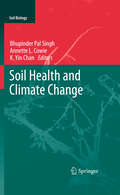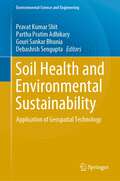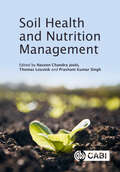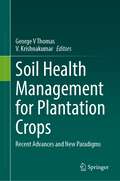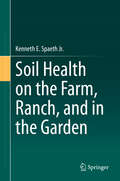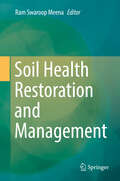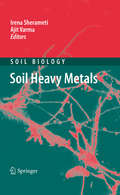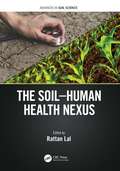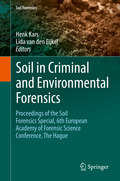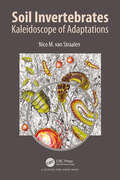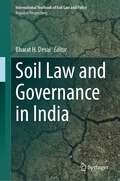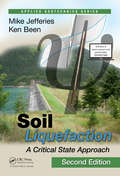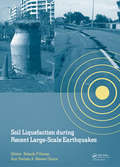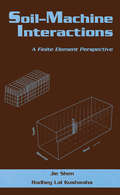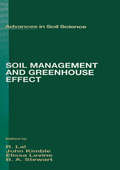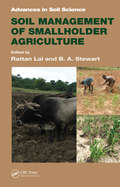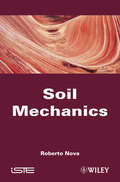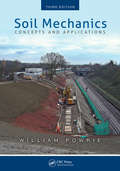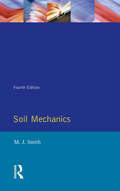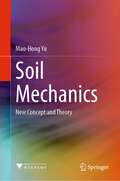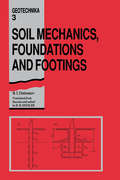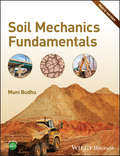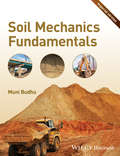- Table View
- List View
Soil Health Analysis, Set (ASA, CSSA, and SSSA Books)
by Douglas L. Karlen Diane E. Stott Maysoon M. MikhaVolume 1 briefly reviews selected &“Approaches to Soil Health Analysis&” including a brief history of the concept, challenges and opportunities, meta-data and assessment, applications to forestry and urban land reclamation, and future soil health monitoring and evaluation approaches.Volume 2 focuses on &“Laboratory Methods for Soil Health Analysis&” including an overview and suggested analytical approaches intended to provide meaningful, comparable data so that soil health can be used to guide restoration and protection of our global soil resources.
Soil Health and Climate Change
by Bhupinder Pal Singh Annette L. Cowie K. Yin Chan"Soil Health and Climate Change" presents a comprehensive overview of the concept of soil health, including the significance of key soil attributes and management of soil health in conventional and emerging land use systems in the context of climate change. Starting with a review of the physical, chemical and biological indicators of soil health and their significance for monitoring the impacts of climate change, this book then focuses on describing the role of soil structure, pH, organic matter, nitrogen, respiration and biota in sustaining the basic functions of soil ecosystems, and their anticipated responses to climate change. Further topics include the management of cropping, pastoral, and forestry systems, and rehabilitated mine sites, with a focus on mitigation of and adaptation to climate change impacts. Finally, the opportunities and potential risks of organic farming, biochar and bioenergy systems, and their ability to sustain and even enhance soil health, are discussed.
Soil Health and Environmental Sustainability: Application of Geospatial Technology (Environmental Science and Engineering)
by Pravat Kumar Shit Partha Pratim Adhikary Gouri Sankar Bhunia Debashish SenguptaThis book demonstrates the measurement, monitoring, mapping and modelling of soil pollution and land resources. This book explores state-of-the-art techniques based on open sources software & R statistical programming and modelling in modern geo-computation techniques specifically focusing on the recent trends in data mining/machine learning techniques and robust modelling in soil resources. Soil and agricultural systems are an integral part of the global environment and human well‐being, providing multiple goods and services essential for people worldwide and crucial for sustainable development. Soil contamination is an environmental hazard and has become a big issue related to environmental health. The challenge of the twenty-first century is to reduce the contaminant load and bring it to below permissible level. The contamination is not only a problem affecting local environments at the place of occurrence but also spreading to other regions because of easy transportation of pollutants. This leads to direct and indirect contamination of land and aquatic systems, surface water and groundwater, inducing significant risks for natural ecosystems. In this context, the spatial modelling, prediction, efficient use, risk assessment, protection and management of soil resources in the agriculture system are the key to achieving sustainable development goals and ensuring the promotion of an economically, socially and environmental sustainability future. The aim of this book on soil contaminants and environmental health: application of geospatial technology is to identify the soil and sediment quality, sources of contaminants and risk assessment and focuses on the decision-making and planning point of view through GIS data management techniques. This book covers major topics such as spatial modelling in soil and sediments pollution and remediation; radioactive wastes, microbiology of soil and sediments, soil salinity and sodicity, pollution from landfill sites, soil erosion and contamination from agricultural activities, heavy metal pollution and health risk; environmental impact and risk assessment, sustainable land use, landscape management and governance, soil degradation and risk assessment, agricultural soil pollution, pollution due to urban activities, soil pollution by industrial effluents and solid wastes, pollution control and mitigation in extreme environments. The content of this book is of interest to researchers, professionals and policy-makers whose work is in soil science and agriculture practices. The book equips with the knowledge and skills to tackle a wide range of issues manifested in geographic data, including those with scientific, societal and environmental implications.
Soil Health and Nutrition Management
A major challenge for agriculture and future crop production is the deterioration in soil health and fertility. We have large areas of barren land across the globe with degraded soil which can only be made fertile by applying proper nutrition and soil health management practices. It is crucial to protect soil health in order to feed the world's ever-growing population. Healthy soil is a dynamic ecosystem containing microbes that aid in the breakdown of organic materials and minerals, increasing the availability of plant nutrients (nutrient recycling) and enhancing soil quality and crop output. Healthy soil also helps mitigate the impact of climate change by maintaining nutrients and sequestering atmospheric carbon. This book summarizes the numerous components of soil health management including cutting-edge technologies such as genome editing and rhizospheric engineering, together with conventional techniques for preserving soil nutrients.
Soil Health Management for Plantation Crops: Recent Advances and New Paradigms
by V. Krishnakumar George V ThomasThis edited volume elucidates state-of-the-art information and provides new paradigms of soil health-based pathways for sustaining plantation crops and diversified systems. The book covers soil characteristics, soil fertility constraints, issues of soil contamination, the impact of climate change on plantation soils, indicators of soil health and soil health assessment, fertility management for healthy soils, soil amendments, soil biodiversity, and biological functions and micro-biome as well as meta-genomic approach.Plantation crops are perennials, cultivated in tropical and sub-tropical agroecosystems in a contiguous area, and comprise estate crops which include tea, coffee, and rubber and small holders’ plantation crops such as coconut, areca nut, oil palm, cashew, cocoa, and spices. These are high-value crops with considerable significance in livelihood security, commerce, and trade, and are grown in ecologically vulnerable regions such as coastal belts, hilly areas, andregions with high rainfall and high humidity, which makes maintenance of soil health a major challenge. Sustainable agricultural production depends on the health, quality, and functionality of the soil. The book includes technological options to achieve sustainable production encompassing soil health improvement through multi-strata, multi-species cropping systems, integrated farming systems, conservation agriculture practices, cover cropping and green manuring, crop residue recycling, bio-fertilizer and bio-stimulant technologies and organic farming systems.This book is an essential resource for researchers, plantation professionals, educators, and policymakers. It provides valuable insights and practical solutions for addressing emerging issues in soil health management and is a must-read for students of agriculture, forestry, ecology, microbiology, soil science, and environmental sciences.
Soil Health on the Farm, Ranch, and in the Garden
by Kenneth E. Spaeth Jr.This book explores the importance of soil health in croplands, rangelands, pasturelands, and gardens, and presents new methods and technologies for assessing soil dynamics and health in these different land types. Through perspectives of agriculture, soil management, and ecological sustainability, the book provides accurate and up-to-date information on soil health assessment and maintenance that is often missing from current literature on conservation and environmental management and preservation. The book is written in a clear and concise format, and will appeal to non-scientists interested in soil health, as well as professional farmers, ranchers and gardeners. The book begins by discussing soil health from a historical perspective, and in terms of how it is covered in the news currently. Then the author addresses the ecological implications of soil health in farming, ranching and gardening, and comprehensively details the physical, chemical and biological properties of soil as they apply in various land types. The book then examines soil health assessment using new diagnostic and analytic technologies, and how these new innovations will be necessary going forward to maintain and improve soil health.
Soil Health Restoration and Management
by Ram Swaroop MeenaMeeting the food requirements of an ever-increasing population is a pressing challenge for every country around the globe. Soil degradation has a negative impact on food security by reducing the cultivated land areas, while at the same time the world population is predicted to increase to 9.2 billion in 2050. Soil degradation adversely affects soil function and productivity and degraded soils now amount to 6 billion ha worldwide. The major factors are salinization, erosion, depletion of nutrients due to exhaustive agricultural practices and contamination with toxic metal ions and agrochemicals, which reduces the activity of soil microbe. In addition, poor soil management also decreases fertility. As such, measures are required to restore the soil health and productivity: organic matter, beneficial microorganisms and nutrient dynamics can all improve the physical, chemical and biological properties of soil. Understanding the role of soil health restoration and management in sustainability and nutritional security calls for a holistic approach to assess soil functions and examine the contributions of a particular management system within a defined timescale. Further, best management practices in cropping systems are important in ensuring sustainability and food and nutritional security without compromising the soil quality and productivity potential. Rational soil management practices must allow environmentally and economically sustainable yields and restoration of soil health.
Soil Heavy Metals
by Ajit Varma Irena SherametiHuman activities have dramatically changed the composition and organisation of soils. Industrial and urban wastes, agricultural application and also mining activities resulted in an increased concentration of heavy metals in soils. How plants and soil microorganisms cope with this situation and the sophisticated techniques developed for survival in contaminated soils is discussed in this volume. The topics presented include: the general role of heavy metals in biological soil systems; the relation of inorganic and organic pollutions; heavy metal, salt tolerance and combined effects with salinity; effects on abuscular mycorrhizal and on saprophytic soil fungi; heavy metal resistance by streptomycetes; trace element determination of environmental samples; the use of microbiological communities as indicators; phytostabilization of lead polluted sites by native plants; effects of soil earthworms on removal of heavy metals and the remediation of heavy metal contaminated tropical land.
The Soil-Human Health-Nexus (ISSN)
by Rattan LalThe term "soil health" refers to the functionality of a soil as a living ecosystem capable of sustaining plants, animals, and humans while also improving the environment. In addition to soil health, the environment also comprises the quality of air, water, vegetation, and biota. The health of soil, plants, animals, people, and the environment is an indivisible continuum. One of the notable ramifications of the Anthropocene is the growing risks of decline in soil health by anthropogenic activities. Important among these activities are deforestation, biomass burning, excessive soil tillage, indiscriminate use of agrochemicals, excessive irrigation by flooding or inundation, and extractive farming practices. Soil pollution, by industrial effluents and urban waste adversely impacts human health. Degradation of soil health impacts nutritional quality of food, such as the uptake of heavy metals or deficit of essential micro-nutrients, and contamination by pests and pathogens. Indirectly, soil health may impact human health through contamination of water and pollution of air.This book aims to:Present relationships of soil health to human health and soil health to human nutrition. Discuss the nexus between soil degradation and malnourishment as well as the important links between soil, plant, animal and human health. Detail reasons oil is a cause of infectious diseases and source of remedial measures.Part of the Advances in Soil Sciences series, this informative volume covering various aspects of soil health appeals to soil scientists, environmental scientists and public health workers.
Soil in Criminal and Environmental Forensics
by Henk Kars Lida EijkelThis introductory volume to a new series on Soil Forensics gives a kaleidoscopic view of a developing forensic expertise. Forensic practitioners and academic researchers demonstrate, by their joint contributions, the extent and complexity of soil forensics. their reports exemplify the broad range of sciences and techniques applied in all stages of forensic soil examinations, from investigations at crime scenes to providing evidence that can be used in court proceedings. Moreover the necessity is depicted of co-operation as a condition for any work in soil forensics between scientists of different disciplines, but no less between scientists and law enforcers. Soils play a role in environmental crimes and liability, as trace evidence in criminal investigations and, when searching for and evaluating, buried human remains. This book shows soil forensics as practiced in this legal context, emerging and solidifying in many countries all over the world, differing in some respects because of differences in legal systems but ultimately sharing common grounds.
Soil Invertebrates: Kaleidoscope of Adaptations
by Nico M. van StraalenSoil invertebrates make up diverse communities living in soil pores and on the soil surface, digging burrows and tunnels, processing organic matter and interacting with microbes. Soil is also a habitat of growing concern as many human activities cause soil degradation. This book documents the evolutionary history of soil invertebrates and their multitude of adaptations. Soil invertebrates live in a twilight zone: some have gone down to seek stability, constancy and rest, others have gone up and faced environmental variation, heat, cold and activity. And it all happens in a few decimetres, millimetres sometimes. Check out the wonderful life below ground in this book.
Soil Law and Governance in India (International Yearbook of Soil Law and Policy)
by Bharat H. DesaiThis curated book addresses, in the scholarly realm, the problems of soil degradation and provides some practical solutions for them to save soil life. It comprises ten specially invited chapters that address the global soil framework, soil challenges in India, existing policy, law and institutional framework as well as other perspectives.Soil is our biological capital. The soil health is critical for survival of the humans (and other life forms) since almost 95% of our food comes from it. It also has significant potential as a sink for carbon through sequestering. Excessive and inappropriate land use leads to various forms of land degradation that becomes contributing factor for hunger, migration and even wars. There are several multilateral environmental agreements (MEAs) including UN Convention to Combat Desertification (UNCCD) that hold relevance for addressing the global soil problematique. The UNCCD Strategic Framework (2018-2030) has declared desertification/land degradation and drought (DLDD) as “challenges of a global dimension”. As a result, sustainable soil management (SSM) has emerged as an important goal for attaining Sustainable Development Goals 2030 (SDGs 2030).In the backdrop of these globally ordained processes, India appears to be seriously pursuing the Land Degradation Neutrality (LDN) target within the framework of the UNCCD. As a corollary, India has set an ambitious goal of halting any further land degradation by 2030 and rehabilitate at least 30 million hectares of degraded wasteland, forest land and agricultural land.This ideational effort by eminent legal scholars, soil scientists and practitioners aim to promote concerted teaching and research in the field of soil law and governance in the University Faculties of Law, National Law Schools, Institutions of Eminence and other legal and scientific bodies. The ‘seeds sown’ in the soil of knowledge through this effort will, hopefully, provide an impetus for more in-depth research concerning soil law and governance in India and beyond.
Soil Liquefaction: A Critical State Approach, Second Edition (Applied Geotechnics)
by Mike Jefferies Ken BeenA Rigorous and Definitive Guide to Soil LiquefactionSoil liquefaction occurs when soil loses much of its strength or stiffness for a time-usually a few minutes or less-and which may then cause structural failure, financial loss, and even death. It can occur during earthquakes, from static loading, or even from traffic-induced vibration. It occurs w
Soil Liquefaction during Recent Large-Scale Earthquakes
by Rolando P. Orense Ikuo Towhata Nawawi ChouwSoil Liquefaction during Recent Large-Scale Earthquakes contains selected papers presented at the New Zealand � Japan Workshop on Soil Liquefaction during Recent Large-Scale Earthquakes (Auckland, New Zealand, 2-3 December 2013). The 2010-2011 Canterbury earthquakes in New Zealand and the 2011 off the Pacific Coast of Tohoku Earthquake in
Soil-Machine Interactions: A Finite Element Perspective
by ShenAiming to improve work efficiency in such areas as tillage in agriculture, earth-moving in civil engineering, and tunnel-making in sea-bed operations, this work offers an introduction to Finite Element Method (FEM) analysis of soil-machine systems. It explains the advantage of FEM's numerical approach over traditional analytical and empirical methods of dealing with complex factors from nonlinear mechanical behaviour to geometric configurations.
Soil Management and Greenhouse Effect (Advances in Soil Science #6)
by John M. Kimble Elissa R. Levine B.A. StewartSoil Management and Greenhouse Effect focuses on proper management of soils and its effects on global change, specifically, the greenhouse effect. It contains up-to-date information on a broad range of important soil management topics, emphasizing the critical role of soil for carbon storage. Sequestration and emission of carbon and other gases are examined in various ecosystems, in both natural and managed environments, to provide a comprehensive overview. This useful reference includes chapters that address policy issues, as well as research and development priorities. The material in this volume is valuable not only to soil scientists but to the entire environmental science community.
Soil Management of Smallholder Agriculture (Advances in Soil Science)
by Rattan Lal B. A. StewartNearly two billion people depend on hundreds of millions of smallholder farmers for food security. Yet, these farmers' lives also hang in the balance due to their extreme vulnerability to the risks of soil degradation and depletion, soil exhaustion, climate change, and numerous biotic and abiotic stresses. Soil Management of Smallholder Agriculture
Soil Mechanics
by Roberto NovaKnowledge of the behavior of soil mechanics is essential for forecasting the internal displacements and actions of any construction. This book, although theoretical at first glance, also offers a more practical scope, giving readers adequate tools to plan geotechnical projects correctly.
Soil Mechanics: Concepts and Applications, Third Edition
by William PowrieInstead of fixating on formulae, Soil Mechanics: Concepts and Applications, Third Edition focuses on the fundamentals. This book describes the mechanical behaviour of soils as it relates to the practice of geotechnical engineering. It covers both principles and design, avoids complex mathematics whenever possible, and uses simple methods and ideas to build a framework to support and accommodate more complex problems and analysis. The third edition includes new material on site investigation, stress-dilatancy, cyclic loading, non-linear soil behaviour, unsaturated soils, pile stabilization of slopes, soil/wall stiffness and shallow foundations. Other key features of the Third Edition:• Makes extensive reference to real case studies to illustrate the concepts described• Focuses on modern soil mechanics principles, informed by relevant research• Presents more than 60 worked examples • Provides learning objectives, key points, and self-assessment and learning questions for each chapter• Includes an accompanying solutions manual for lecturersThis book serves as a resource for undergraduates in civil engineering and as a reference for practising geotechnical engineers.
Soil Mechanics
by Michael John SmithFirst published in 1989. This series was originally designed as an aid to students studying for technical examinations, the aim of each book being to provide a clear concise guide to the basic principles of the subject, reinforced by worked examples carefully selected to illustrate the text. This book has been prepared with the object both of helping the student pass an examination, and for the practising engineer. The subject-matter of Soil Mechanics, has been restricted to basic principles, and worked examples are selected to give good coverage.
Soil mechanics
by David Muir WoodThis 2009 book teaches the principles of soil mechanics to undergraduates, along with other properties of engineering materials, to which the students are exposed simultaneously. Using the critical state method of soil mechanics to study the mechanical behavior of soils requires the student to consider density alongside effective stresses, permitting the unification of deformation and strength characteristics. This unification aids the understanding of soil mechanics. This book explores a one-dimensional theme for the presentation of many of the key concepts of soil mechanics - density, stress, stiffness, strength, and fluid flow - and includes a chapter on the analysis of one-dimensional consolidation, which fits nicely with the theme of the book. It also presents some theoretical analyses of soil-structure interaction, which can be analyzed using essentially one-dimensional governing equations. Examples are given at the end of most chapters, and suggestions for laboratory exercises or demonstrations are given.
Soil Mechanics: New Concept and Theory
by Mao-Hong YuThis book focuses on the unified solutions and analysis for the problems in soil mechanics based on the unified strength theory, which is a new theory on the yield and failure of materials under multi-axial stresses. Then, it provides a system of yield and failure criteria adopted for most materials, from metallic materials to rocks, concretes, soils, polymers, etc. It includes the Tresca criterion, Mohr–Coulomb theory, and Mises criterion as well, which are special cases or linear approximation of the UST.
Soil Mechanics, Footings and Foundations: Geotechnika - Selected Translations of Russian Geotechnical Literature 3
by B.I. DalmatovTranslated from the second Russian edition of 1988. Parts 2, "Soil mechanics" and 3, "Foundations and footings" are revised and updated versions of the first Russian edition of 1981. Part 1, "Special course in engineering geology," contains a discussion of physicomechanical properties of soil, geody
Soil Mechanics Fundamentals
by Muniram BudhuAn accessible, clear, concise, and contemporary course in geotechnical engineering, this key text: strikes a balance between theory and practical applications for an introductory course in soil mechanics keeps mechanics to a minimum for the students to appreciate the background, assumptions and limitations of the theories discusses implications of the key ideas to provide students with an understanding of the context for their application gives a modern explanation of soil behaviour is presented particularly in soil settlement and soil strength offers substantial on-line resources to support teaching and learning
Soil Mechanics Fundamentals
by Muniram BudhuThis accessible, clear and concise textbook strikes a balance between theory and practical applications for an introductory course in soil mechanics for undergraduates in civil engineering, construction, mining and geological engineering. Soil Mechanics Fundamentals lays a solid foundation on key principles of soil mechanics for application in later engineering courses as well as in engineering practice. With this textbook, students will learn how to conduct a site investigation, acquire an understanding of the physical and mechanical properties of soils and methods of determining them, and apply the knowledge gained to analyse and design earthworks, simple foundations, retaining walls and slopes. The author discusses and demonstrates contemporary ideas and methods of interpreting the physical and mechanical properties of soils for both fundamental knowledge and for practical applications. The chapter presentation and content is informed by modern theories of how students learn: Learning objectives inform students what knowledge and skills they are expected to gain from the chapter. Definitions of Key Terms are given which students may not have encountered previously, or may have been understood in a different context. Key Point summaries throughout emphasize the most important points in the material just read. Practical Examples give students an opportunity to see how the prior and current principles are integrated to solve ‘real world’ problems.

